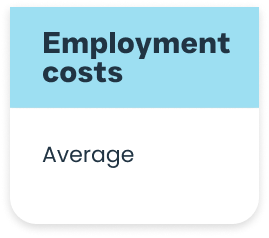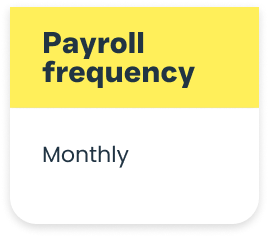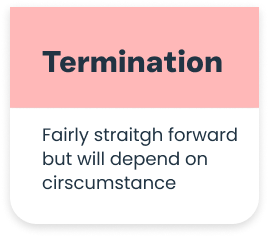Quadlux UK country guide







Introduction to United Kingdom
United Kingdom Human Resources
UK employment law is derived from two main sources:
UK labor law legislation (which has supplemented the common law rules)
Common law (custom and practice and court decisions)
Employment Contracts
There should always be a compliant written contract between the Employee and Employer.
The agreement is that the employee will work for the employer and the employer’s agreement to pay the employee for the work forms a contract.
The following details must all be included in the contract or an accompanying principal statement of written terms:
- Employer’s name and the employee name
- Start date (official day the worker starts work with the employer)
- Date that ‘continuous employment’ (working for the same employer without a significant break) started for an employee
- Job title
- Employer’s address and the location (address) where the employee will work
- Pay, including frequency and when (for example, £3,000 per month, paid on the last working day of each month)
- Working hours, including which days the worker must work, if the worker is on a flexible contract state how their hours or days can change
- Paid time off (vacation pay), including details of how it is calculated in the event the employee leaves the company
- Number of sick leave days and pay (if this information is not included in the contract, the employer must outline where the information can be located)
- Any other paid leave (if this information is not included in the contract, the employer must outline where the information can be located)
- Any other benefits, including non-contractual benefits such as childcare vouchers or company car schemes
- The notice period either party must provide before employment ends
- Any probation period, (include the expected period of the probation)
- If the employee will need to travel
Guidelines Regarding Probation Period
It is usual for the Employment contract to state the employee will be subject to a probationary period at the start of their employment, during which the employer can take the opportunity to assess the employee’s fit for the role. While the exact terms of the probationary period will be governed by the employment contract, Probation periods usually last three months. The maximum period (including any extension) is six months. During the probationary period, the employee may not be entitled to certain benefits.
Contract Terms
Contract Terms
Regulations and Rules Regarding Working Hours in United Kingdom
Working hours in the United Kingdom are regulated but the Working Time Regulations 1998 (WTR). The WTR sets a maximum of 48 hours for the working week (although workers can opt out of this restriction). Workers may not work on average more than 48 hours per week, this is normally calculated over a 17 week reference period. A typical standard white-collar working week will be 37.5 hours.
The Working Time Regulation also states an employee’s right to daily, weekly and in work rest periods.
United Kingdom Laws Regarding Overtime
Should employers require their employees to work longer than their normal working hours, they should ensure the employment contract provides for this with an overtime clause. This clause should clarify whether or not the overtime will be paid. Typically overtime rates are 1.5 times the basic rate for weekdays and two times the basic rate for weekends and public holidays.
Bonus schemes are a common practice in the UK. These bonuses can be either guaranteed within the Employment contract, discretionary or a mixture of the both. Ultimately this means that you can be considered for a bonus, however the employer has the final approval on any discretionary bonus pay outs.
In the UK employees are entitled to a period of notice to bring the contract to an end unless they have committed an act of gross misconduct. If the employee has not committed an act of gross misconduct the contract will continue until it is brought to an end in accordance with its terms. Normally either by giving the required notice or making a payment in lieu of notice if this is provided for in the contract.
For employees without unfair dismissal rights (with less than two years’ service) employers can dismiss without a fair reason so long as they do not dismiss on the basis of a discriminatory or automatically unfair reason and they comply with the terms of the contract of employment. It is automatically unfair to dismiss an employee for a wide variety of reasons. This includes dismissing an employee because they have taken advantage of statutory rights to maternity, paternity or parental leave or exercised their right to join or participate in trade union activity these are a few examples but there are numerous other reasons.
Once an employee has two years’ service, they will have right against unfair dismissal and the employer may only dismiss for one of five prescribed legitimate and fair reasons. A fair procedure must also be followed, to avoid unfair dismissal.
Legitimate (fair) reasons to dismiss an employee:
- misconduct
- capability or qualifications
- redundancy
- application of a statutory restriction (for example the employee no longer has a right to work in the UK)
- for “some other substantial reason” (“SOSR”)
SOSR is often, for example, because an employee has refused to agree to a variation in terms and conditions of employment. The courts in the UK apply a narrow interpretation as to whether an employer’s reason constitutes “SOSR”.
The UK statutory minimum notice period for employees is as follows:
- Employed for less than one month – no entitlement to statutory notice period.
- Employed for one month to two years – minimum one week’s notice.
- Employed for two to twelve years – minimum two weeks notice, plus an extra week for each additional year of continuous employment, up to a maximum of twelve weeks.
In the UK, there is no legal right to receive severance pay, but many employers will offer it as part of their redundancy packages.
Severance or redundancy package’s for your employees would usually include a lump sum payment based on length of service and salary. It is also common for employees to be paid a sum in lieu of notice, usually equal to the value of pay over the notice period.
Restrictive covenants and non-compete clauses (sometimes known as post-termination restrictions) are clauses within a contract of employment or a Settlement Agreement which prevent a leaving employee from taking clients or key employees from their former employer, or working for a competitor. These are generally enforced once the employment relationship has ended.
Types of Restrictive Covenants:
- Non-compete: This restricts an employee’s ability to work for certain competitors or carry on a competing business for a certain period of time after termination.
- Non-solicitation of customers: This prohibits an employee from soliciting certain clients or customers of their former employer for a certain period of time after termination.
- Non-solicitation of employees: This prohibits an employee from soliciting certain employees of their former employer for a certain period of time after termination.
- Non-dealing: This prohibits an employee from doing business with certain clients or customers of their former employer for a certain period of time after termination.
Restrictive covenants are not automatically valid and enforceable simply because they have been incorporated into a contract of employment. In fact, there is a presumption that restrictive covenants are automatically void for being in restraint of trade and contrary to public policy, unless the employer can show both of the following, the employer has a legitimate proprietary interest that is appropriate to protect with the restrictive covenant. Or, the protection sought is no more than reasonable having regard to the interests of the parties and the public interest.
Fixed-term workers may be contracted to work for a fixed period of time only, or to perform a particular project with the contract terminating at the end of this period, or on the completion of the project. Examples are those who are employed specifically to cover for maternity or paternity leave; employees hired to cover unusual peaks in demand as in the tourist industry; and employees whose contracts will end on the completion of a specific project. There is no requirement for fixed-term contracts to specify the reason why it has been concluded for a fixed-term, although a job title should be included in the contract. This is done to comply with the employer’s statutory requirements on the written statement of particular conditions of employment.
The regulations say that where an employee has been continuously employed on successive fixed-term contracts for four years or more (from July 10, 2002), the employee will automatically receive permanent status.
Tax and Social Security Information for Employers in United Kingdom
Personal Income Tax in UK
The standard employee personal allowance for the 2023 to 2024 tax year is:
The table shows the tax rates you pay in each band if you have a standard Personal Allowance of £12,570.
(Please note: The above Rates are valid for England and Wales. The Scottish government set its own rates which are broadly similar)
Employers are obliged to deduct and make tax payments (due from salary income) to the tax authorities on the employees’ behalf.
Social Security in United Kingdom
Both the employee and the employer are required to contribute to National Insurance (NI). The rates and salary bands are as follows from 6 April 2024 to 5 April 2025:
The employer is obligated to make the national Insurance contributions and income tax payments through the PAYE system.
The above rates serve as a broad guideline. Actual rates charged by Quadlux will differ.
Apprenticeship Levy
The apprenticeship levy is a type of tax to support companies in offering apprenticeships, the apprenticeship levy ensures that employers contribute to apprenticeship training supporting skill development and workforce growth. It is a tax paid by employers and stored in a fund which can be accessed to fund apprenticeship training costs.
Employers with an annual payroll of more than £3 million have to contribute, which is 0.5% of total payroll paid monthly via PAYE.
Important Information for Employees in The UK
Salary payments are usually paid monthly on the last day of the month or a few days before that.
By law, employers must provide employees with a payslip. The employer can chose to provide a printed or an electronic payslip to the employee. The payslip must be provide on or before payday.
The payslip must, at a minimum, show:
- Earnings before and after any deductions
- The amount of any deductions that may change each time the employee is paid (e.g. tax and national insurance)
- The number of hours worked (if the pay varies depending on time worked)
Employers must also explain any deductions fixed in amount, for example repayment of a season ticket loan. They can elect to do this either on a payslip or through a separate written statement.
Employees are entitled to a statutory minimum of 28 days paid annual leave per annum. This holiday entitlement can include public holidays, of which there are currently eight in England and Wales (20 working days + 8 public holidays). An employer can choose to offer more leave than the legal minimum. They do not have to apply all the rules that apply to statutory leave to the extra leave. For example, a worker might need to be employed for a certain amount of time before they become entitled to it.
The statutory minimum of 20 days must be used in the holiday year. Otherwise, they will be lost except under exceptional circumstances such as long-term sickness, pregnancy or maternity leave etc.
There is no legal limit on how many sick days per year UK employees can take. However, there are rules on when staff are entitled to Statutory Sick Pay (SSP). Employees who are sick for at least four consecutive days (including weekends and public holidays) are entitled to sick leave, which is subject to certain conditions. They will receive statutory sick pay (SSP). The standard weekly rate of SSP is currently £109.40.
Many employers offer enhanced rates of sick pay (company sick pay), typically paying full salary for the first two to three weeks at least
Unpaid Parental Leave: Eligible employees are entitled to 18 weeks’ unpaid parental leave to care for a child under eighteen. An employee can normally take only four weeks’ parental leave in any one leave year. For short periods of leave ,due to child sickness, many employers offer formal or informal arrangements for paid leave.
Parental leave is different from maternity or paternity leave.
There is no legal entitlement to compassionate or bereavement leave in the UK. However most employers choose to offer a period of compassionate leave to employees. Typically, compassionate leave can be up to 5 days, broken down as follows 3-5 days for the loss of an immediate family member, 2-3 days for a less close relationship and 1 day for in-laws, aunts, uncles and cousins.
An employee has the right to time off for a funeral if the person who died was a dependent. This includes, for example, their partner or parent. There’s no legal right for this period of time off to be compensated. However, most employers will offer some period of unpaid leave.
Maternity Leave
Pregnant employees/new mothers are entitled to up to 52 weeks’ the 52 weeks is made up of 26 weeks ordinary maternity leave and 26 weeks additional maternity leave.
An employee’s usual terms and conditions of employment will continue throughout the period of maternity leave however salary is replace with Statutory Maternity pay (SMP). The amount the employee receives depends on their earnings. The first 6 weeks of SMP are earnings related and they will get a weekly rate equal to 90% of their average weekly earnings (there is no upper limit). The remaining 33 weeks are paid at the weekly standard rate SMP of £139.58 (from 5 April 2015) or the earnings related rate if this is less than standard rate SMP.
A woman returning to work from leave generally has the right to return to the job in which she was employed before her absence, subject to the duration of her maternity leave.
Paternity Leave
Paternity leave is available to employees with 26 weeks’ continuous service. Eligible employees are entitled to take one or two weeks’ paternity leave, which is payable at the rate of £172.48 per week or 90% of average weekly earnings, if less. Many employers pay paternity pay at an enhanced rate (dependent on company paternity pay policy).
Shared Parental Leave
Shared parental leave allows mothers to end maternity leave/pay early so that one or both parents can take leave in a more flexible way. Parents can take time off at the same time or separately**.** The balance of the maternity leave and pay period is available for either parent to take as shared parental leave. The leave must be taken in the first twelve months of a child’s life but does not have to be taken as a single continuous period.
Adoption Leave
Up to 52 weeks’ adoption leave is available to one member of an adopting couple. Adoption pay is paid at the same rates as statutory maternity pay. Adoptive parents can opt in to the shared parental leave system if the parent taking adoption leave elects to end their period of leave early. The Employee can also get paid time off work to attend 5 adoption appointments after they have been matched with a child.
England and Wales have eight annual public holidays. Scotland and Northern Ireland may additionally have local public holidays. Days are observed on that calendar day and if falling on a weekend.
Benefits to the Employee in The United Kingdom
The UK maintains a comprehensive social security system, funded by general taxation and from National Insurance Contributions. The social security system provides state benefits to cover leave in maternity, paternity, adoption, childcare, disability and carer matters. Within Social security system the UK also has the National Health Service for medical needs. It also administers pensions for retirement. Employers can contractually supplement state benefits. The National Insurance Fund aims to provide subsistence level benefits to all those in need.
Employers carrying on business in the UK are required to have in place employer’s liability insurance against liability for bodily injury or disease sustained by employees and arising out of and in the course of their employment in the UK. Some employers offer employees benefits such as life insurance, permanent health insurance and private medical insurance.
Employers have to ensure that workers, between the ages of 22 and state pension age, and earning a salary of at least GBP 10,000 per annum are automatically enrolled into a qualifying pension scheme to which the employer is required to contribute. There are minimum total contributions that have to be made. Currently, the total contribution rate is 8%. This includes a minimum for employers this is 3% of each employee’s qualifying earnings.
In 2023, qualified earnings are defined by HMRC as amounts of 6,240 GBP and 50,270 GBP. It is possible to contribute to a pension on total earnings and this can be applied at employer’s and employee’s discretion and should be agreed and stated in the employment contract. Employees have the right to opt out of the scheme but if so they are also not eligible for the employer’s contribution.
Employers may offer employees benefits such as life insurance, permanent health insurance, private medical insurance, subsidized gym membership etc.
Employees with at least 26 weeks’ continuous service has the statutory right to make a flexible working request (for example, to work on a part-time basis). The employer must consider the request reasonably and within three months of the request being made but is not obliged to agree to it.
Rules Regarding Visas and Foreign Workers
An individual is eligible to work in the UK and therefore will not need to obtain a work permit if any of the following apply the individual is a British citizen, European Economic Area (EEA) citizen or a Swiss national.
Due to the UK having left the EU on 31 January 2020, any EU/EEA/Swiss national you (includes all family members) will usually need to apply to the EU Settlement Scheme if they wish to continue living and working in the UK after 30 June 2021. If the application is successful, individuals will get either settled or pre-settled status. Irish nationals maintain their current right to live and work in the UK without further documentation.
Should the individual be from outside the European Economic Area (EEA) and Switzerland, they can work in the UK on a short or long-term basis with a work visa. If the individual has a visitor visa, they cannot take a job in the UK. There are many types of work visas in the UK. The visa an individual will need depends upon one of the following:
- skills and qualifications
- if there is a job offer and sponsorship
- if they wish to bring family members with them
- what work will be performed (e.g. there are special visas for sporting, charitable or religious work)
- If they are a Commonwealth citizen (they can apply for an Ancestry Visa to work in the UK if they have a British grandparent and meet other eligibility criteria)
The individual should be able to apply for a visa via a British Overseas Mission in their own country or at the British Embassy. In order to apply for most work visas, the individual will usually need to gain a job offer with sponsorship from an employer in the UK first. While some organizations have a license to sponsor temporary or permanent employees, not all employers have this ability.
Having a visa does not necessarily mean the individual will automatically be able to work in the UK. They may also need to obtain a work permit in order to begin working. If the individual has already sourced a job in the UK and has been accepted to work (or holds a visa but it prohibits them from working) they may need to obtain a work permit. An individual cannot apply for a work permit directly, their employer in the UK will need to apply on their behalf. The length of the permit will depend on the type of work and the kind of permit granted.
All employees have to pay tax on income if they come to live in the UK and have the right to work. Employers will deduct income tax directly from the employee’s salary.
Everyone who works in the UK is required to have a National Insurance (NI) Number. Without one, employers have no way of advising the British Tax Department (HM Revenue and Customs) of the amounts they need to pay as NI contributions for state pension and the social security system. The worker will be charged a potentially substantial emergency tax on their income until they have obtained a NI Number. They can start work without one but will need to apply for one right away.
The National Insurance number is the individual’s own personal account number. It is unique to each individual and stays the same throughout life. It makes sure the National Insurance contributions and taxes paid are properly recorded against the individual’s name. It also acts as a reference number when communicating with the Department for Communities and HM Revenue & Customs (HMRC).
If an individual has the right to work in the UK, they can go to the following website Apply for a National Insurance number: How to apply – GOV.UK (www.gov.uk) to apply.
For the application You’ll need to prove your identity when you apply.
If you have any of the following documents, get them ready before you start:
a passport from any country
a biometric residence permit ()
BRP
a national identity card from an EU country or from Norway, Liechtenstein or Switzerland
You might need to enter information from one or more of these documents.
You can still apply if you do not have any of these documents, but you may need to attend an appointment in person to prove your identity.
You will also need to prove your identity, you will need the following:
- a photo of yourself holding your passport
- photos of other identity documents
You can use a smartphone, tablet or a digital camera. You’ll be told how to take the photos and what they must look like during the application process.
if you cannot upload your photos you can still apply online but your application will take longer.
You may need to attend an appointment or post photocopies of your documents. You’ll get an email telling you what to do after you’ve submitted your application.
Once the application is completed the National Insurance Number can take up to 4 weeks to come through.


